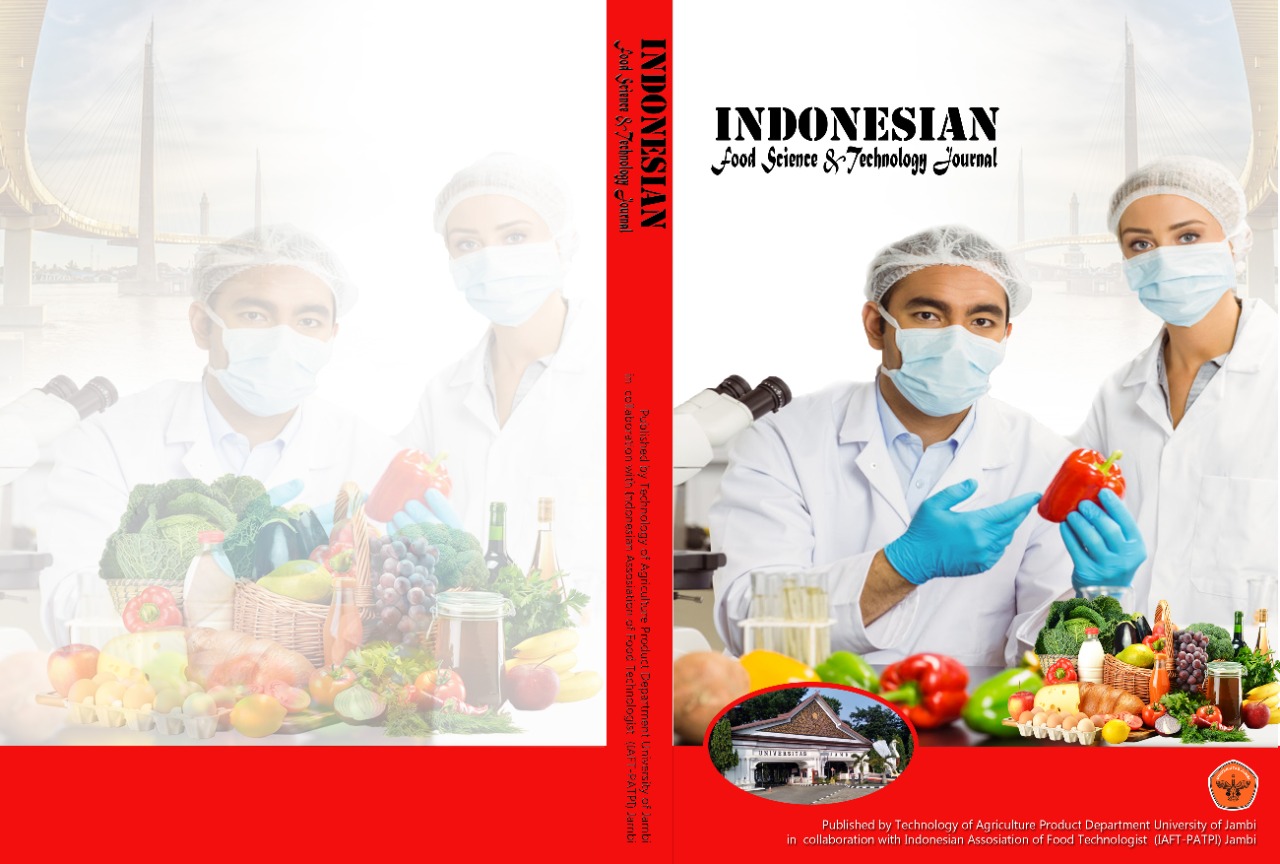Innovation of Goat's Milk Soft Candy with Annatto Extract (bixa orellana l.) As Natural Colorant and Antioxidant
DOI:
https://doi.org/10.22437/ifstj.v7i1.29836Keywords:
annato, antioxidant, goat's milk, natural colorant, soft candyAbstract
The research aims to produce innovative soft candy from goat's milk and annatto extract as colorants and antioxidants that consumers like. Soft candy product innovations were studied in random group designs consisting of five concentrations of annatto extract (0%, 0.15%, 0.20%, 0.25%, and 0.30%). The results showed that the addition of annatto extract in the goat's milk soft candy formula decreases the L value, along with an increase of a* and b values so that the color of the soft candy becomes orange. Increasing the concentration of annatto extract causes a significant increase in antioxidant activity. The addition of annatto extract in the goat's milk candy formulation influenced the level of preference for the color attribute but did not affect the aroma, taste, and texture attributes. The goat's milk soft candy with the addition of 30% annatto extract as a natural colorant and antioxidant produced the best physicochemical and sensory characteristics based on index effectivity value. This soft candy resulted in a water content of 7.46±0.74%, ash content of 0.57±0.07%, and antioxidant activity of 69.20±1.07%. The addition of annatto extract also does not affect the ash content or water content of the goat's milk soft candy produced.Downloads
References
T. Voblikova, A. Permyakov, A. Rostova, G. Masyutina, and A. Eliseeva, ‘Study of Fatty-acid Composition of Goat and Sheep Milk and Its Transformation in the Production of Yogurt’, KnE Life Sci., vol. 2020, pp. 742–751, 2020, doi: 10.18502/kls.v5i1.6161.
G. A. Nayik, Y. D. Jagdale, S. A. Gaikwad, A. N. Devkatte, A. H. Dar, and M. J. Ansari, ‘Nutritional Profile, Processing and Potential Products: A Comparative Review of Goat Milk’, Dairy, vol. 3, no. 3, pp. 622–647, 2022, doi: 10.3390/dairy3030044.
X. Y. Li et al., ‘Change in the structural and functional properties of goat milk protein due to pH and heat’, J. Dairy Sci., vol. 103, no. 2, pp. 1337–1351, 2020, doi: 10.3168/jds.2019-16862.
T. Michlová, H. Dragounová, R. Seydlová, and A. Hejtmánková, ‘The hygienic and nutritional quality of milk from Saanen goats bred in the Moravian-Silesian region’, Agron. Res., vol. 14, no. S2, pp. 1396–1406, 2016.
S. Verruck et al., ‘Dairy foods and positive impact on the consumer’s health’, Adv. Food Nutr. Res., vol. 89, pp. 95–164, 2019, doi: 10.1016/bs.afnr.2019.03.002.
E. Altınok, I. Palabiyik, R. Gunes, O. S. Toker, N. Konar, and S. Kurultay, ‘Valorisation of grape by-products as a bulking agent in soft candies: Effect of particle size’, LWT- Food Sci. Technol., vol. 118, p. 108776, 2020, doi: 10.1016/j.lwt.2019.108776.
E. Sulistyowati, R. P. A. Ningsih, Y. P. Trinata, S. Suharyanto, and E. Soetrisno, ‘Salad dressing soft candy made of dairy goat milk with the addition of red dragon fruit (hylocereus polyrhizuz): Nutritional content, physical and organoleptic properties’, E3S Web Conf., vol. 373, 2023, doi: 10.1051/e3sconf/202337304004.
Musdalifa, M. Chairany, N. Haliza, and F. Bastian, ‘Microencapsulation of three natural dyes from butterfly pea, Sappan wood, and turmeric extracts and their mixture base on cyan, magenta, yellow (CMY) color concept’, Canrea J. Food Technol. Nutr. Culin. J., vol. 4, no. 2, pp. 91–101, 2021, doi: 10.20956/canrea.v4i2.496.
S. B. Handayani, I., Haryanti, P. and Sulistyo, ‘Color and antibacterial activity of annatto extracts at various pH of distilled’, Food Res., vol. 5, no. December, pp. 247–253, 2021.
C. R. Cardarelli, M. de T. Benassi, and A. Z. Mercadante, ‘Characterization of different annatto extracts based on antioxidant and colour properties’, Lwt, vol. 41, no. 9, pp. 1689–1693, 2008, doi: 10.1016/j.lwt.2007.10.013.
M. U. Shankar, C. A. Levitan, and C. Spence, ‘Grape expectations: The role of cognitive influences in color-flavor interactions’, Conscious. Cogn., vol. 19, no. 1, pp. 380–390, 2010, doi: 10.1016/j.concog.2009.08.008.
W. Rahmalia, A. Shofiyani, Y. S. K. Dewi, and S. Septiani, ‘Simple Green Routes for Metal-Bixin Complexes Synthesis Using Glycerol-Based Deep Eutectic Solvent’, Indones. J. Chem., vol. 22, no. 6, pp. 1759–1767, 2022, doi: 10.22146/ijc.76759.
P. L. Bellinazo et al., ‘Probiotic butter: Viability of Lactobacillus casei strains and bixin antioxidant effect (Bixa orellana L.)’, J. Food Process. Preserv., vol. 43, no. 9, pp. 1–9, 2019, doi: 10.1111/jfpp.14088.
N. Intan Oktaviani, W. Rahmalia, and I. Syahbanu, ‘Karakterisasi Sabun Minyak Biji Ketapang(Terminalia catappa L.) Dengan Penambahan Ekstrak Kesumba (Bixa orellana L.) Sebagai Pewarna Alami’, J. Kim. Khatulistiwa, vol. 7, no. 3, pp. 118–124, 2018.
P. T. Ina, G. A. K. D. Puspawati, G. A. Ekawati, and G. P. G. Putra, ‘Pemanfaatan Ekstrak Ubi Ungu sebagai Pewarna Merah pada Soft Candy dan Stabilitasnya’, agriTECH, vol. 39, no. 1, pp. 20–29, 2019, doi: 10.22146/agritech.32195.
L. Wang et al., ‘Physicochemical Aspects and Sensory Profiles as Various Potential Factors for Comprehensive Quality Assessment of Nü-Er-Cha Produced from Rhamnus heterophylla Oliv.’, Molecules, vol. 24, no. 18, p. 3211, 2019, doi: 10.3390/molecules24183211.
AOAC, Official Methods of Analysis of The Association of Official Analytical Chemist. Virginia USA: Association of Official Analytical Chemist, Inc, 1995.
AOAC, Official Methods of Analysis of The Association of Official Analytical Chemist. Virginia USA: Association of Official Analytical Chemist, Inc, 2005.
Y. S. K. Dewi, S. Purwayantie, F. Christian, D. Fadly, and C. J. K. Simamora, ‘Phytochemicals, Antioxidant Activities, And Toxicity Evaluation of Several Fractions f Scorodocarpus borneensis Becc. Leaves’, Rasayan J. Chem., vol. 15, no. 1, pp. 705–710, 2022, doi: 10.31788/RJC.2022.1516580.
E. . De Garmo, W. . Sullivan, and J. . Canada, Engineering Economy. New York: Milan Publishing Company, 1984.
E. E. Nianti, B. Dwiloka, and B. E. Setiani, ‘Pengaruh Derajat Kecerahan, Kekenyalan, Vitamin C, dan Sifat Organoleptik pada Permen Jelly Kulit Jeruk Lemon (Citrus medica var Lemon)’, J. Teknol. Pangan, vol. 2, no. 1, pp. 64–69, 2018.
N. N. Husa, F. Hamzah, and H. M. Said, ‘Characterization and Storage Stability Study of Bixin Extracted from Bixa orellana Using Organic Solvent’, in IOP Conference Series: Materials Science and Engineering, 2018, vol. 358, no. 1, p. 012035, doi: 10.1088/1757-899X/358/1/012035.
I. Handayani, A. T. Septiana, and B. Sustriawan, ‘Karakteristik Warna (Hue, Value dan Chroma) Ekstrak Annatto pada Perlakuan Variasi pH Pelarut dan Waktu Ekstraksi’, Pengemb. Sumber Daya Perdesaan Dan Kearifan Lokal Berkelanjutan XI, pp. 292–301.
I. V. Plotnikova, G. O. Magomedov, I. M. Zharkova, E. N. Miroshnichenko, and V. E. Plotnikov, ‘Jelly formulated with different carbohydrate profiles: Quality evaluation’, Foods Raw Mater., vol. 10, no. 2, pp. 262–273, 2022, doi: 10.21603/2308-4057-2022-2-535.
D. Karmila, D. T. Cahyono, and I. Nairfana, ‘Effect Of Variation Of Ginger Extract On Color Brightness, Water Content, Degree Of Acidity (pH) And Organoleptic Quality Of Jelly Candy Cashew Extract (Anacardium occidentale L.)’, Food Agro-Industry J., vol. 3, no. 1, pp. 55–72, 2022.
A. Ramadhanty, D. F. Rosida, and R. Yulistiani, ‘Chemical and Organoleptic Properties of Dragon Fruit Gummy Candy and Apple Snail Collagen Extract with Carrageenan Addition’, AJARCDE (Asian J. Appl. Res. Community Dev. Empower., vol. 7, no. 3, pp. 3–8, 2023, doi: 10.29165/ajarcde.v7i3.328.
D. Liu, M. Nikoo, G. Boran, P. Zhou, and J. M. Regenstein, ‘Collagen and Gelatin’, Annu. Rev. Food Sci. Technol., vol. 6, pp. 527–557, 2015, doi: 10.1146/annurev-food-031414-111800.
P. Burey, B. R. Bhandari, R. P. G. Rutgers, P. J. Halley, and P. J. Torley, Confectionery Gels: A Review on Formulation, Rheological and Structural Aspects, vol. 12, no. 1. 2009.
H. Ge, Y. Wu, L. L. Woshnak, and S. H. Mitmesser, ‘Effects of Hydrocolloids, Acids and Nutrients on Gelatin Network in Gummies’, Food Hydrocoll., vol. 113, no. 2021, p. 106549, Apr. 2021, doi: 10.1016/j.foodhyd.2020.106549.
A. Bigi, S. Panzavolta, and K. Rubini, ‘Relationship Between Triple-helix Content and Mechanical Properties of Gelatin Films’, Biomaterials, vol. 25, no. 25, pp. 5675–5680, 2004, doi: 10.1016/j.biomaterials.2004.01.033.
S. Santinath Singh, V. K. Aswal, and H. B. Bohidar, ‘Internal Structures of Agar-gelatin co-hydrogels by Light Scattering, Small-angle Neutron Scattering and Rheology.’, Eur. Phys. J., vol. 34, no. 62, pp. 1–9, 2011, doi: 10.1140/epje/i2011-11062-3.
C. L.C. Albuquerque and M. A.A. Meireles, ‘Trends in Annatto Agroindustry: Bixin Processing Technologies and Market’, Recent Patents Eng., vol. 5, no. 2, pp. 94–102, 2011, doi: 10.2174/187221211796320738.
M. A. Valério, M. I. L. Ramos, J. A. Braga Neto, and M. L. R. Macedo, ‘Annatto Seed Residue (Bixa orellana L.): Nutritional Quality’, Food Sci. Technol., vol. 35, no. 2, pp. 326–330, 2015, doi: 10.1590/1678-457X.6539.
D. A. Hayati, N. Ginting, T. H. Wahyuni, E. R. Mirwandhono, and H. Hasnudi, ‘Pemanfaatan Daun Kelor (Moringa oleyfera) Terhadap Kandungan Gizi pada Permen Karamel dari Susu Kambing’, Talent. Conf. Ser. Agric. Nat. Resour., vol. 1, no. 2, pp. 192–197, 2018, doi: 10.32734/anr.v1i2.236.
Y. A. Labola and D. Puspita, ‘Peran Antioksidan Karotenoid Penangkal Radikal Bebas Penyebab Berbagai Penyakit’, Farmasetika.com (Online), vol. 2, no. 5, p. 12, 2017, doi: 10.24198/farmasetika.v2i2.13668.
M. Cornelia and C. Nathania, ‘Utilization of Carrot (Daucus carota L.) Extract and Gold Kiwi (Actinidia deliciosa) Juice in the Making of Jelly Candy’, FaST - J. Sains dan Teknol., vol. 4, no. 2, pp. 31–45, 2020.
J. Kojić et al., ‘Textural, Color and Sensory Features of Spelt Wholegrain Snack Enriched with Betaine’, Foods, vol. 11, p. 475, 2022, doi: 10.3390/foods11030475.
E. M. Rahim, R. Fadhilla, P. Ronitawati, P. D. Swamilaksita, and H. Harna, ‘Penambahan Ekstrak Serai (Cymbopogon citratus) dan Ekstrak Tomat (Solanum lycopersicum) Terhadap Nilai Gizi, Kandungan Fe, dan Vitamin C pada Permen Jelly’, J. Nutr., vol. 21, no. 2, pp. 75–82, 2019, doi: 10.29238/jnutri.v21i2.145.
P. I. Dike, O. O. Ibojo, F. Y. Daramola, and O. A. Conrad, ‘Phytochemical and proximate analysis of foliage and seed of Bixa orellana linn’, Int. J. Pharm. Sci. Rev. Res., vol. 36, no. 2, pp. 247–251, 2016.
M. Ali, S. U. Diso, S. A. Waiya, and M. . Abdallah, ‘Phytochemical Screening and Antibacterial Activity of Bitter Leaf (Vernonia amygdalina)’, Ann. Microbiol. Infect. Dis., vol. 2, no. 1, pp. 1–7, 2021.
F. Fadlilaturrahmah, A. M. P. Putra, M. I. Rizki, and T. Nor, ‘Uji Aktivitas Antioksidan dan Antitirosinase Fraksi n-Butanol Daun Sungkai (Peronema canescens Jack.) Secara Kualitatif Menggunakan Kromatografi Lapis Tipis’, J. Pharmascience, vol. 8, no. 2, p. 90, 2021, doi: 10.20527/jps.v8i2.11160.
Downloads
Published
How to Cite
Issue
Section
License
Copyright (c) 2023 Indonesian Food Science and Technology Journal

This work is licensed under a Creative Commons Attribution 4.0 International License.







